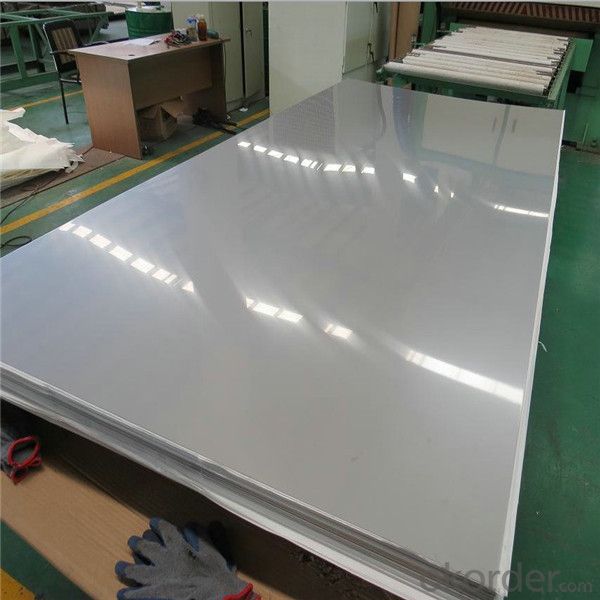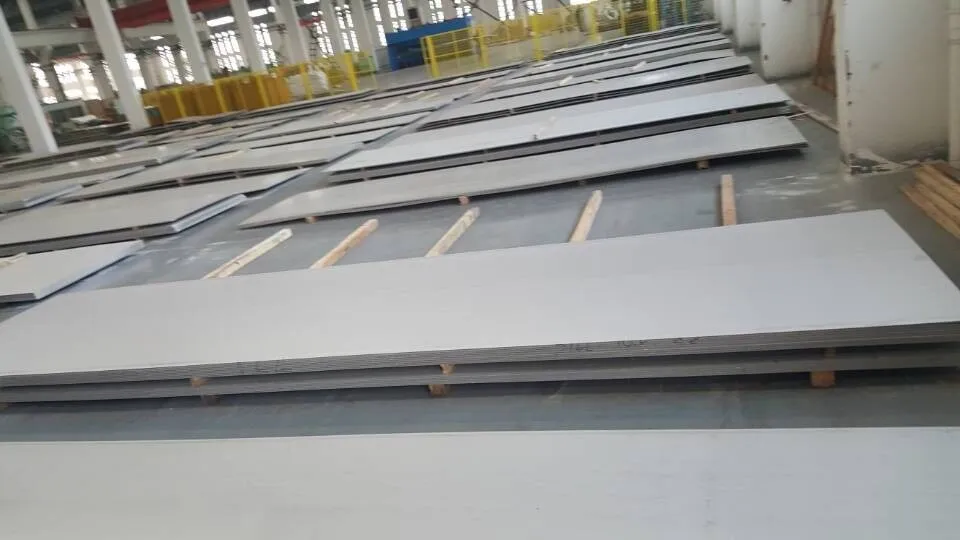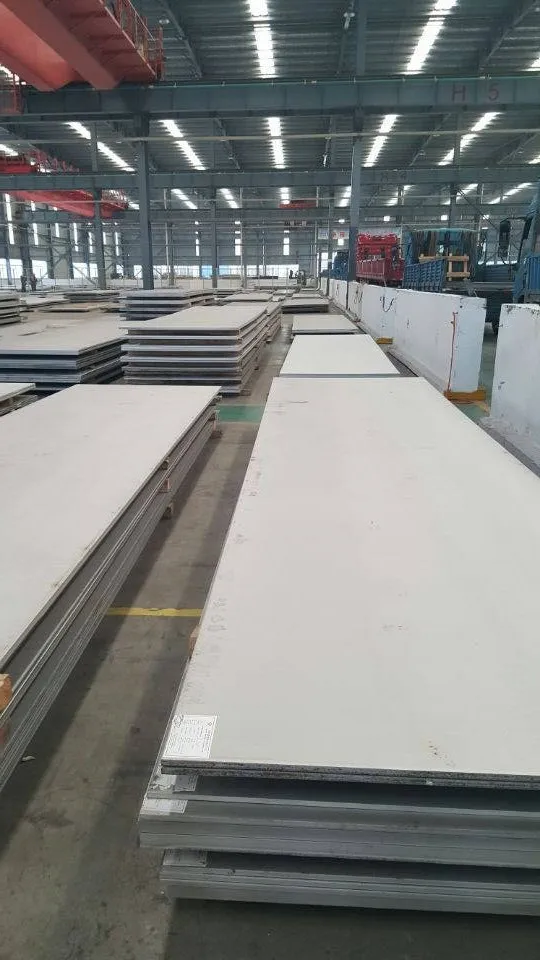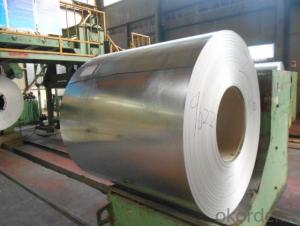Stainless Steel Plate 2520 duplex 1219x2438mm
- Loading Port:
- Shanghai
- Payment Terms:
- TT OR LC
- Min Order Qty:
- 3 m.t.
- Supply Capability:
- 20000 m.t./month
OKorder Service Pledge
OKorder Financial Service
You Might Also Like
Item specifice
2205 2507 2520 duplex stainless steel plate
We are a professional manufacturer of stainless steel sheet. According to ASTM, JIS and AISI,GB, standards, Jaway steel enhances effectiveness and of quality control from selecting the raw materials, cutting, slitting, shearing, surface treatment, packing, exporting of the existing products.
Product Description
Details of Stainless Steel Sheet/Plate: > > > > > > > > > > > > > > > > >
2205 stainless steel plate
Type | Stainless steel plates/Stainless plate/Stainless sheet |
Thickness | 1mm-140mm |
Width | 2000mm |
Length | 1m---8mm or as customer |
Standard | JIS,ASME,ASTM,EN etc |
Material | 201,202,301,304,304L,316,316L,317, 317l ,321,309S,310S,410,2Cr13,3Cr13,2205 |
Brand name | TISCO,BG,ZPSS,YUSCO,JISCO,BXIN,KSK,KRUPP |
Application range | Foodstuff, gas, metallurgy, biology, electron, chemical, petroleum, boilers, nuclear, energy and medical equipment, fertilizer, etc |
Packing | Standard export sea-worthy packing or as the customer’s requirement |
Productivity | 500 tons per month |
Note | We can produce other standards as the customer’s requirement |
Products Show
These are the normal items, for the special requirements,we can also meet.
Surface finish | Characteristics and application |
NO.2B | The surface brightness and flatness of no2B is better than no2D. then through a special surface treatment to improve its mechanical properties,No2B could nearly satisfy comprehensive uses. |
NO.3 | Polished with abrasive belt of git#100-#200, have better brightness with discontinuous coarse stria, used as inner and external ornaments for building, electrical appliances and kitchen utensils etc. |
NO.4 | Polished with abrasive belt of grit #150-#180,have better brightness with discontinuous coarse stria,but thinner than No3, are used as bathtub buildings inner and external ornaments electrical appliances kitchen utensils and food processing equipment etc. |
HL | Polished with abrasive belt of grit #150-#320 on the NO.4 finish and has continuous streaks, mainly used as buildings ornaments elevators,door of building, frontal plate etc. |
BA | Cold rolled, bright annealed and skin-passed, the product have excellent brightness and good reflexivity like mirror,kitchen apparatus,ornament etc. |
8K | The product have excellent brightness and prefer reflexivity can to be the mirror. |


Our Advantages
• All products are made of high-quality imported raw materials.
• Our products are certified by ISO9001:2008 authentication quality systems.
• we are nominated as the AAA enterprise by Jiangsu government.
• Quick Response to Your Enquiry.
- Q:Can stainless steel sheets be cold rolled?
- Yes, stainless steel sheets can be cold rolled. Cold rolling is a process in which a stainless steel sheet is passed through a series of rollers at room temperature, reducing its thickness and increasing its hardness and strength. This process can be used to produce stainless steel sheets with precise dimensions and surface finishes. Cold rolling is commonly used in the manufacturing of stainless steel sheets for various applications such as automotive components, kitchen appliances, and architectural structures.
- Q:What is the minimum order quantity for stainless steel sheets?
- The minimum order quantity for stainless steel sheets can vary depending on the supplier and the specific product. However, it is common for suppliers to have a minimum order quantity ranging from 1 to 10 sheets. It is important to contact different suppliers and inquire about their minimum order requirements to find the best option that suits your needs.
- Q:How do you remove adhesive from stainless steel sheets?
- One effective way to remove adhesive from stainless steel sheets is by applying a small amount of rubbing alcohol or acetone to a soft cloth and gently rubbing the adhesive residue. Another option is to use a mixture of warm water and mild soap, followed by scrubbing with a non-abrasive sponge or cloth. If the adhesive is particularly stubborn, using a commercial adhesive remover specifically designed for stainless steel can also be effective.
- Q:What is the difference between the stainless steel plate and the second board?
- Stainless steel rolling will have uneven thickness significantly phenomenon, characteristics of whole plate on both sides of the middle thick thin stainless steel board material, generally does not appear such phenomenon
- Q:What is the electrical resistivity of stainless steel sheets?
- The electrical resistivity of stainless steel sheets varies depending on the specific grade or alloy composition of the stainless steel. Generally, stainless steel has a relatively low electrical resistivity compared to other materials, such as copper or aluminum. The resistivity can range from approximately 6.9 x 10^-7 ohm-meters (Ωm) for austenitic stainless steel to 7.2 x 10^-7 Ωm for ferritic stainless steel. It is important to note that these values are approximate and can vary slightly based on factors such as temperature and impurities in the stainless steel.
- Q:Are stainless steel sheets suitable for brewery equipment?
- Yes, stainless steel sheets are highly suitable for brewery equipment. Stainless steel is a preferred material in the brewing industry due to its many beneficial properties. Firstly, stainless steel is resistant to corrosion, making it ideal for equipment that comes into contact with liquids and chemicals used in the brewing process. This corrosion resistance helps maintain the quality and purity of the beer being brewed. Additionally, stainless steel is easy to clean and sanitize, which is crucial in maintaining hygiene standards in a brewery. It is non-porous, meaning it does not absorb or retain odors, flavors, or bacteria, ensuring the beer is not contaminated during production. Stainless steel also has a smooth surface, preventing the buildup of bacteria or other contaminants that could affect the quality of the beer. Furthermore, stainless steel is durable and long-lasting, able to withstand the demanding conditions of a brewery environment, including high temperatures, moisture, and constant use. This durability ensures that brewery equipment made from stainless steel sheets will have a longer lifespan, reducing the need for frequent replacement or repairs. Overall, stainless steel sheets are an excellent choice for brewery equipment due to their corrosion resistance, ease of cleaning, sanitation properties, and durability. Using stainless steel in brewery equipment helps maintain the quality and purity of the beer, ensuring a better end product for consumers.
- Q:What are the different methods of cutting stainless steel sheets?
- There are several methods for cutting stainless steel sheets, including shearing, laser cutting, waterjet cutting, plasma cutting, and abrasive cutting. Each method has its advantages and is suitable for different applications and thicknesses of stainless steel.
- Q:How do you drill holes in stainless steel sheets?
- To achieve accurate and clean results, it is necessary to follow specific steps and use the right tools when drilling holes in stainless steel sheets. Here is a detailed guide on how to accomplish this task: Step 1: Gather the required tools, including a drill machine, suitable drill bits for stainless steel (cobalt or carbide are recommended), a center punch, safety goggles, work gloves, and a clamp or vise to secure the stainless steel sheet. Step 2: Select the appropriate drill bit. Since stainless steel is a tough material, regular drill bits may not be effective. Instead, opt for cobalt or carbide drill bits that are specifically designed for cutting through hard metals. Step 3: Mark the hole position by using a center punch to create a small indentation at the exact spot where you intend to drill. This will prevent the drill bit from slipping when starting the hole. Step 4: Firmly secure the stainless steel sheet using a clamp or vise on a workbench or surface. This will prevent any movement during drilling and ensure precise and clean holes. Step 5: Prioritize safety by wearing safety goggles and work gloves to protect your eyes and hands from metal debris and sharp edges. Step 6: Begin drilling by placing the drill bit on the marked indentation and applying gentle pressure to start the hole. Use a lower speed setting on your drill machine to prevent overheating, gradually increasing the pressure as you continue drilling. Step 7: Apply cutting fluid or lubricant on the drill bit while drilling to reduce friction and heat buildup. This will extend the life of the drill bit and prevent discoloration or warping of the stainless steel sheet due to excessive heat. Step 8: Monitor the drilling progress and adjust the speed and pressure accordingly. It is crucial to maintain a steady pace and avoid applying excessive force to prevent drill bit breakage or damage to the stainless steel sheet. Step 9: Periodically stop drilling to remove metal debris from the hole, ensuring that it does not clog and that the hole remains clean. Step 10: Once the desired hole size is achieved, slowly withdraw the drill bit from the stainless steel sheet. Use a file or deburring tool to smooth out any rough edges around the hole. By following these steps and utilizing the appropriate tools, you can successfully drill precise and clean holes in stainless steel sheets. Remember to take your time, prioritize safety, and properly maintain your tools for optimal results.
- Q:How do I prevent stress corrosion cracking on stainless steel sheets?
- To prevent stress corrosion cracking on stainless steel sheets, there are various steps that can be taken: 1. Opt for the appropriate stainless steel grade: Select a stainless steel grade that is resistant to stress corrosion cracking (SCC). Although grades like 304 and 316 generally have good SCC resistance, certain applications may necessitate higher alloyed grades like duplex or super duplex stainless steels. 2. Minimize exposure to corrosive environments: Limit the exposure of stainless steel sheets to environments known to cause stress corrosion cracking, such as chloride-rich or acidic surroundings. If avoiding exposure is not possible, consider applying protective coatings or barriers to shield the stainless steel from these corrosive elements. 3. Manage applied stress levels: Prevent subjecting the stainless steel sheets to excessive mechanical or thermal stresses. High tensile stresses can facilitate the initiation and propagation of stress corrosion cracking. Utilize appropriate design and fabrication techniques to ensure even stress distribution and minimize stress concentrations. 4. Maintain the surface condition: Ensure that the stainless steel sheets are devoid of surface contamination or defects that can serve as initiation sites for stress corrosion cracking. Regularly clean and inspect the sheets to eliminate any contaminants or corrosion products. 5. Employ inhibitors or cathodic protection: In certain cases where exposure to corrosive environments is unavoidable, the use of corrosion inhibitors or the implementation of cathodic protection techniques can help mitigate stress corrosion cracking. These methods work by reducing the corrosive activity on the stainless steel surface. 6. Handle and store properly: Exercise caution during transportation and storage to prevent excessive bending, vibration, or exposure to corrosive substances. Store stainless steel sheets in a clean and dry environment to avoid potential surface contamination. In conclusion, a combination of material selection, environmental control, stress management, surface maintenance, and proper handling can effectively prevent stress corrosion cracking on stainless steel sheets. It is advisable to consult with material experts or engineers to analyze specific application requirements and recommend the most appropriate preventive measures.
- Q:Are stainless steel sheets good for cryogenic storage?
- Yes, stainless steel sheets are suitable for cryogenic storage due to their excellent resistance to low temperatures and high strength. They can withstand extreme cold without becoming brittle or losing structural integrity, making them a reliable choice for storing materials at cryogenic temperatures.
1. Manufacturer Overview |
|
|---|---|
| Location | |
| Year Established | |
| Annual Output Value | |
| Main Markets | |
| Company Certifications | |
2. Manufacturer Certificates |
|
|---|---|
| a) Certification Name | |
| Range | |
| Reference | |
| Validity Period | |
3. Manufacturer Capability |
|
|---|---|
| a)Trade Capacity | |
| Nearest Port | |
| Export Percentage | |
| No.of Employees in Trade Department | |
| Language Spoken: | |
| b)Factory Information | |
| Factory Size: | |
| No. of Production Lines | |
| Contract Manufacturing | |
| Product Price Range | |
Send your message to us
Stainless Steel Plate 2520 duplex 1219x2438mm
- Loading Port:
- Shanghai
- Payment Terms:
- TT OR LC
- Min Order Qty:
- 3 m.t.
- Supply Capability:
- 20000 m.t./month
OKorder Service Pledge
OKorder Financial Service
Similar products
New products
Hot products
Related keywords


































